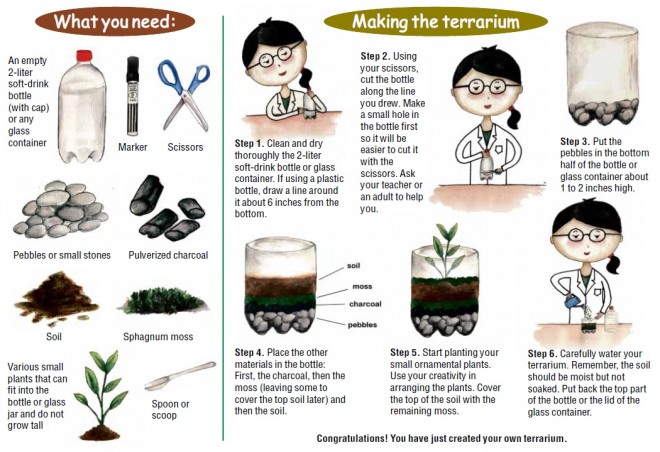Make your own terrarium
Do you know what a terrarium is?
It sounds like aquarium, doesn’t it?
Like an aquarium, a terrarium is a miniature ecosystem. But where an aquarium shows the interaction of water organisms, a terrarium consists of plants.
It shows how a community of living organisms, like plants and microbes, interacts with nonliving components in their environment, such as air, water and soil.
A terrarium is a mini garden inside a glass or transparent container, like an empty soft-drink bottle or glass jar.
Can you guess where we are headed? Can you imagine having your own terrarium in your living room or your classroom?
Article continues after this advertisementThis is not exactly an experiment but a science project that can be done individually, in pairs or in groups. This is a nice way to teach about plants and closed environments. You can observe the life cycle of plants as they grow.
Article continues after this advertisementLet’s now build your own terrarium!
What you need:
An empty 2-liter soft-drink bottle (with cap) or any glass container
Pebbles or small stones
Pulverized charcoal
Sphagnum moss
Soil
Scissors
Marker
Spoon or scoop
Various small plants that can fit into the bottle or glass jar and do not grow tall
Making the terrarium
Step 1. Clean and dry thoroughly the 2-liter soft-drink bottle or glass container. If using a plastic bottle, draw a line around it about 6 inches from the bottom.
Step 2. Using your scissors, cut the bottle along the line you drew. Make a small hole in the bottle first so it will be easier to cut it with the scissors. Ask your teacher or an adult to help you.
Step 3. Put the pebbles in the bottom half of the bottle or glass container about 1 to 2 inches high.
Step 4. Place the other materials in the bottle: First, the charcoal, then the moss (leaving some to cover the top soil later) and then the soil.
Step 5. Start planting your small ornamental plants. Use your creativity in arranging the plants. Cover the top of the soil with the remaining moss.
Step 6. Carefully water your terrarium. Remember, the soil should be moist but not soaked. Put back the top part of the bottle or the lid of the glass container.
Congratulations! You have just created your own terrarium.
The Science
The pebbles allow excess water to flow to the bottom of the bottle to prevent the soil from getting soaked and muddy. The charcoal serves as a filter to purify the water while the moss acts as a screen to keep the soil on top while allowing water to flow smoothly to the bottom. The soil provides plants the nutrition they need. Nutrients are absorbed from the soil by the plants’ roots.
Terrariums create a unique environment for the plant to live and grow. The transparent wall of the bottle or glass container allows both heat and light to enter the terrarium.
As sunlight raises the temperature inside the bottle, water evaporates or rises, accumulating along the sides and at the top. When the water droplets get too heavy, they will fall like rain and the process is repeated. This demonstrates the cycle of water flow—how rain is formed.
The light that passes through the transparent wall of the terrarium also allows plants to photosynthesize, an important aspect of their growth.
Photosynthesis is the process through which plants and other organisms convert light energy, normally from the sun, into chemical energy that fuels the organisms’ activities.
Takeaway learning
We need plants as much as plants need us. We get our food and oxygen from them. As we are part of the bigger ecosystem, we need to interact with other living organisms, including animals and especially our fellow human beings, as well as nonliving organisms and the environment we are in.
Tip: With Christmas fast approaching, think about making terrariums to give to family, friends and even teachers.
Using the newspaper
This terrarium project gives you an opportunity to reuse an empty soft-drink plastic bottle. Look in the Inquirer for news about people who are practicing recycling to keep our landfills from overfilling.
Form a group with four or five of your classmates. As a group, make a recycling plan for your school.
There is something in your classroom right now that you can creatively recycle into something else. Newspapers can be made into envelopes, small baskets, place mats, frames, etc.
As a group, choose one creative project for recycling newspapers. Once you have crafted your project, give it a name and stick a label on it with the names of everyone in your group.
This recycled newspaper project should be submitted to your teacher, who will then turn it over to the Inquirer.
About the series
The joy of discovery. The fun of learning.
These are the experiences that Bayer wants to pass on to young people in keeping with its mission, “Bayer: Science for a Better Life,” and its enthusiasm for research.
By putting together simple, educational and fun experiments, elementary school students are encouraged to learn science by doing science.
The Bayer Smiling Kiddie Einsteins series offers teachers, parents and students hands-on and inquiry-based experiences that involve observing, experimenting, hypothesizing, analyzing and testing.
Through this series of experiments related to health, agriculture-nutrition and hi-tech materials, Bayer and Inquirer in Education aim to deepen the interest of elementary pupils in Science.
The materials needed for these experiments are safe and can easily be accessed from your homes.
